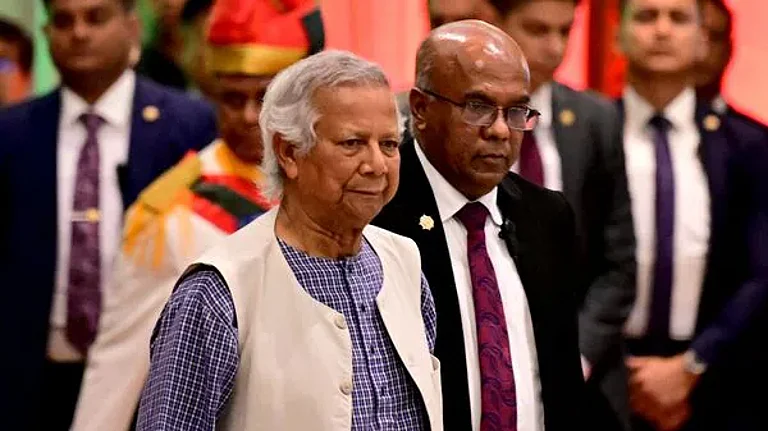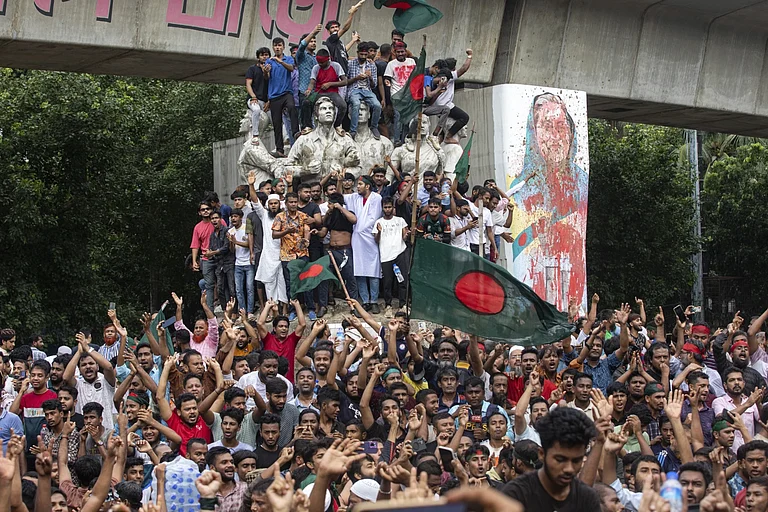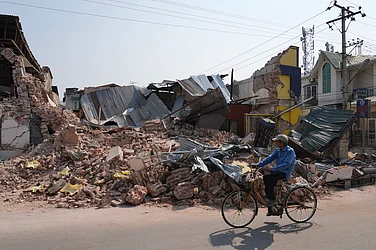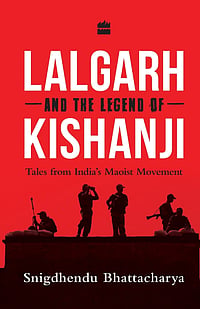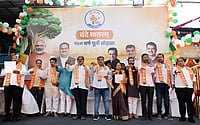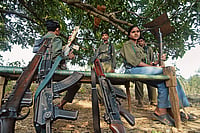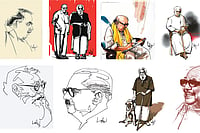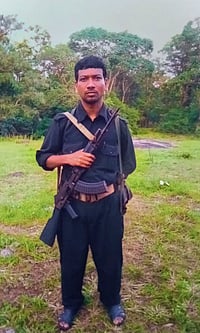A three-week-long student-led mass movement in Bangladesh has toppled Prime Minister Sheikh Hasina’s Awami League (AL) government ruling the country since 2008.
Hasina, South Asia’s longest-serving Prime Minister, tendered her resignation on Monday afternoon and fled the country in an army helicopter, bringing an almost certain end to her political career in Bangladesh, the last three weeks of which recorded about 400 to 600 deaths, according to various estimates.
The outcome of the dramatic uprising was confirmed by the army chief, Waqar Uz Zaman, after 3 pm local time in Bangladesh. He said that Hasina had resigned and an interim government will take charge. He had already held a discussion with representatives of opposition parties like the Bangladesh Nationalist Party (BJP), the recently-proscribed Jamaat e Islami (JeI) and the Jatiyo Party.
Later in the night, President Mohammed Shahabuddin announced that the interim government would try to ensure free and fair elections at the earliest; all political prisoners, including former Prime Minister Khaleda Zia and those involved in the recent anti-government protests, would be released; and everyone involved with murders (of anti-government protesters) would be brought to justice.
After Hasina fled along with her sister, Rehana, hundreds of protesters entered her residence, Gana Bhavan in the national capital of Dhaka, and looted properties in a scene quite similar to that of the mass loot and vandalism of the Sri Lanka President’s palace two years ago.
According to Dhaka-based social media researcher Apon Das, the people have earned an initial victory by bringing down an autocrat but the achievements must be held on to.
“Currently, the country has descended into lawlessness, which was inevitable. Multiple efforts are on to create myriad controversies around the movement, including attacks on religious minorities and destruction of public properties,” Das tells Outlook over the phone.
He hopes the student leadership will succeed in retaining the same influence over the masses that they enjoyed over the past three weeks.
From her July 14 comments outraging students protesting against job quota for freedom fighters’ kin to her hurried exit from the country – leaving almost all her belongings – on August 5, Bangladesh witnessed in just 22 days the overthrow of a government ruling the country since 2008.
The AL government ruled with an iron hand, mostly in the name of fighting terror, but it also earned the government of being an autocratic regime. Opposition parties like the BNP and JeI were rendered mostly leaderless, with their top leadership either in jail or in exile, facing from terror to corruption charges.
“Despite almost fishing off her political opponents, the past few days’ experience shows that resentment against her rule had grown deep,” a senior Dhaka-based journalist tells Outlook.
Hasina, the daughter of the country’s founding leader Sheikh Mujibur Rahman, first served as the prime minister between 1996 and 2001 and returned to power in 2008. However, all three successive parliamentary elections – in 2013, 2018 and 2024 – were tainted.
The opposition boycotted the 2013 election demanding an election under an interim government, alleged that the 2018 election was totally rigged, and again boycotted the 2024 parliamentary election.
Hasina was sworn in for her fourth consecutive term only half a year ago, while the opposition alleged that she enjoyed no popularity and was ruling by use of partisan state machinery.
A Comment That Started the Fire
The anti-reservation protests started on July 5 after a court scrapped the government’s 2018 order abolishing 30 per cent job quotas for families of freedom fighters. The government had abolished the quota after a similar agitation in 2018.
After the court reinstated the quota system in July, students hit the streets demanding government action to ensure the reservation for freedom fighter families was not reintroduced. Students argued that the third generation of freedom fighters no longer needed reservations.
However, while responding to the quota versus merit debate, PM Hasina made some remarks on July 14 that sparked outrage among protesters.
She said, “Quota and merit are not the same. It’s a divisive tactic. What do they mean? The children of freedom fighter families are not meritorious and merit lies in the families of Razakars?”
Her throw of the words “Razakar-er bachha” (the closest English equivalent is ‘son of a Razakar’) reflected a sense considered insulting or derogatory.
Hasina went on to say, “We cannot forget that the freedom fighters had defeated them. The Razakars lost to freedom fighters despite licking the boots of the Pakistanis. They were defeated. Where do you see merit in them?”
Razakar is a controversial and divisive word in Bangladesh, as it refers to the paramilitary force made of pro-Pakistan Bangladeshi locals raised by the Pakistan army when East Pakistan, under the leadership of Sheikh Mujibur Rahman, declared separation from West Pakistan in 1971.
To many Bangladeshis, Razakar is a hated identity – the group of people who colluded with an occupying army to kill freedom fighters.
However, her statements equating anti-quota protesters with Razakars angered the students. From that night, the situation gradually went out of the government’s control.
Thousands of students marched inside and outside college and university campuses on the night of July 14, with the slogan “Amra Sobai Razakar” – we are all Razakars.
While a section of civil society members and the ruling party leaders said the Amra Sobai Razakar slogan was unacceptable, students explained that their slogan was sarcastic, reflecting the irony of the PM’s remarks.
Meanwhile, the death of Rangpur’s Begum Rokeya University student Abu Sayed in police firing on July 16 triggered a huge uproar. An unarmed Sayeed was seen facing the cops with his hands stretched out, inviting the police to shoot him in the chest. To the shock of a large majority of people, Sayeed was, indeed, shot dead.
Sayeed became an icon-martyr of the movement and the image of him facing the cops with his hands stretched out on two sides emerged as one of the most powerful images of the student agitation. “It drew thousands and thousands more to the streets,” a Bangladeshi journalist tells Outlook.
Blackout and Bullets
As protests gained momentum, the government first blocked some news websites, social media platforms and messaging apps. But on July 17, a complete shutdown of mobile internet and broadband services was imposed, which continued for 10 days.
However, the number of deaths (estimated at over 300), arrests and detentions by the security forces during these days added fuel to the fire, as even bigger public gatherings happened after the people got to know all that had happened during the days of the internet blackout.
Students, who initially had a nine-point demand, reduced their demands to a single-point agenda – the resignation of the prime minister and her cabinet. The movement had transformed.
Finally, the last nail in the government’s coffin was driven by the ruling party itself when it decided to counter the agitation by mass mobilisation on the street.
A chain of dramatic developments happened on Sunday. Students initially called for a long march to the national capital from all parts of the country on August 6, following which the government promptly announced a nationwide curfew and mobile internet shutdown.
Responding to this, the students called for advancing the programme and asked people to march for the national capital on August 5.
Meanwhile, AL’s ‘mobilisation programme’ meant hundreds of cadres hitting the streets armed with sharp and blunt weapons and firearms, often accompanied by the police.
“Sunday was the worst day of all. More than a hundred died on a single day and most of these deaths were in firing by the police and AL cadres,” says another journalist.
As news of these deaths poured in, people started marching for Dhaka on Sunday night itself, as many considered it a do-or-die situation.
On Monday morning, as thousands started entering the city, a complete internet shutdown was imposed at 10.30 am Bangladesh time. It was lifted at 12.30 local time. By that time, Hasina’s fate had been sealed.
New Challenge
After Hasina fled and the army chief announced initiatives to form an interim government, news of attacks on several AL leaders and ministers came pouring in from different parts of the country.
In a statement issued in the evening, BNP chief Tarique Rahman, who lives in London in exile, urged the people in a statement to “refrain from seeking revenge or retribution”. His mother, former prime minister Khaleda Zia, was released from internment on Sunday night itself.
“The joy of victory is truly exalted when the vanquished are secure in the hands of the victor. I urge the people of Bangladesh to celebrate this triumphant moment peacefully,” Rahman said.
Meanwhile, student movement coordinators said that they would announce their position on the army chief’s proposal for interim government after further discussions.
“We will not accept an army-backed government or an Emergency under President’s Rule. We will announce our programme and our demands on the interim government within the next 24 hours,” student leader Nahid Islam and Asif Mahmud said at a press meet in the night.
Later, as reports of deaths and vandalism in attacks on the residences of AL leaders and supporters, including religious minorities, came pouring in, the student leadership issued an appeal, calling upon all the participants of the student-citizen uprising and the general public to initiate ward-based “Communal Harmony and State Property Protection Committees” across the country.
According to Salimullah Khan, a public intellectual who teaches at the University of Liberal Arts (U-LAB), the student movement was an outcome of the resentment that “had been growing over the past 16 years of autocratic rule.” People’s inability to express their resentments through elections burst out in the form of street agitation, he feels.
“While there is hope that the young generation wants to rebuild the nation, there also are apprehensions, as we are already getting news of the demolition of historic sculptures, attacks on police establishments and the residences of AL supporters and religious minorities. This is a betrayal of the true nature and spirit of the student-led movement,” he says.
He hopes the students will fight these evils as well.






.jpeg?w=801&auto=format%2Ccompress&fit=max&format=webp&dpr=1.0)

